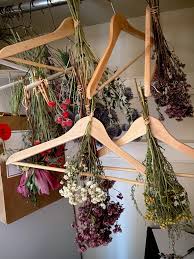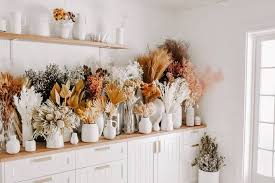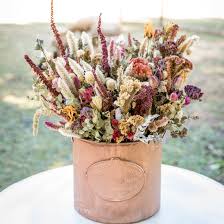Dried flowers, with their delicate and preserved petals, have the enchanting ability to evoke a sense of timeless beauty and elegance. These stunning botanical treasures, once alive and vibrant, undergo a meticulous preservation process to maintain their allure long after their natural bloom fades away.
With their array of colors, textures, and fragrances, dried flowers have become a popular choice for various purposes, from home decor to artistic creations. Let us delve into the fascinating world of dried flowers and explore their enduring charm.
The art of preserving flowers dates back centuries, with ancient cultures recognizing the inherent beauty and symbolic meanings associated with these delicate blooms. The practice of drying flowers gained prominence as a way to savor the ephemeral nature of blossoms and extend their lifespan beyond the confines of a short-lived season.
Today, dried flowers continue to captivate our hearts and minds, offering a unique way to bring a touch of nature’s splendor into our lives throughout the year.
One of the most significant advantages of dried flowers lies in their longevity. Unlike fresh flowers, which wither and fade within days, dried blooms can retain their allure for months or even years. Through careful drying techniques, flowers are able to maintain their original shape, color, and texture, allowing us to enjoy their beauty long after they have been harvested.
The preservation process typically involves hanging the flowers upside down in a well-ventilated area, away from direct sunlight, to facilitate the gradual evaporation of moisture. This gentle dehydration process ensures that the flowers maintain their shape and color while preventing mold or decay. Once dried, these blossoms can be arranged in a myriad of ways to suit various preferences and purposes.
Dried flowers offer endless possibilities when it comes to home decor. They can be artfully arranged in vases or incorporated into wreaths and garlands, adding a touch of natural elegance to any living space. Whether adorning a table centerpiece or gracing a mantelpiece, these timeless botanical wonders effortlessly infuse a sense of serenity and sophistication into our surroundings.
Beyond their decorative applications, dried flowers have also found their way into the realm of artistic pursuits. Crafters and artisans utilize dried blooms to create exquisite floral arrangements, pressed flower artwork, and even handmade paper. These creations serve as a testament to the enduring allure of dried flowers, showcasing their ability to inspire creativity and become a medium for self-expression.
Moreover, dried flowers have gained popularity in various ceremonies and celebrations. From weddings to birthdays, their presence adds a nostalgic and sentimental touch to special occasions. Dried flower bouquets and boutonnieres not only provide an alternative to fresh blooms but also serve as cherished keepsakes, allowing us to hold onto cherished memories long after the event has passed.
Another significant advantage of dried flowers is their sustainability. As they are preserved, they require no water or sunlight, reducing the environmental impact associated with cultivating fresh flowers. In a world where sustainable practices are gaining increasing importance, dried flowers offer a responsible and eco-friendly choice for those seeking natural beauty without compromising the planet’s resources.
In addition, dried flowers are a captivating testament to nature’s enduring grace and splendor. With their timeless beauty and versatility, they have become a cherished choice for home decor, artistic endeavors, and special occasions.
Preserving the essence of flowers long after their natural bloom, dried blossoms offer us the opportunity to experience the wonders of nature in a sustainable and lasting way. So, whether adorning our living spaces or serving as artistic inspiration, dried flowers continue to weave their magic, reminding us of the enduring beauty found in even the most fleeting moments of life.
Read Also: Water Snakes (Nerodia): Species, Habitat, Diet, & More
Uses of Dried Flowers

Dried flowers have a wide range of uses, thanks to their versatility and long-lasting nature. Here are some popular applications for dried flowers:
1. Home Decor: Dried flowers make stunning additions to home decor. They can be arranged in vases or displayed in decorative bowls, adding a touch of natural beauty to any room. Dried flower wreaths and garlands are also popular choices for adorning doors, walls, and fireplace mantels, creating a charming and inviting atmosphere.
2. Crafts and Artwork: Dried flowers are cherished by crafters and artists alike. They can be used to create pressed flower art, where flowers are carefully arranged and preserved between glass or paper to create beautiful designs. Dried flowers are also commonly incorporated into handmade cards, scrapbooking, and jewelry-making, allowing for unique and personalized creations.
3. Potpourri and Sachets: Dried flowers are often used to make fragrant potpourri or sachets. By combining dried flowers with aromatic herbs, spices, and essential oils, you can create delightful blends that emit a gentle and natural fragrance. These potpourri mixtures can be placed in bowls, sachets, or decorative pouches, imparting a pleasant scent to drawers, closets, and living spaces.
4. Wedding Decorations: Dried flowers have become increasingly popular in weddings, offering a vintage and romantic touch. They are used in bridal bouquets, boutonnieres, and floral arrangements for ceremonies and receptions. Dried flowers can also be incorporated into centerpieces, table settings, and wedding favors, providing a lasting memento for the couple and guests.
5. Natural Confetti and Throwing Petals: Dried flower petals are a wonderful alternative to traditional confetti at celebrations. They can be tossed during weddings, birthdays, and other special events, creating a whimsical and eco-friendly shower of color. Dried flower petals are also used for scattering along aisles or pathways, adding a charming and fragrant element to outdoor ceremonies.
6. Herbal Remedies and Potions: Some dried flowers possess therapeutic properties and are used in herbal remedies and natural potions. For example, dried lavender flowers are known for their calming effects and can be used in sleep aids, bath salts, or herbal teas. Calendula flowers are often dried and infused in oils or salves for their skin-soothing properties.
7. Culinary Uses: Certain dried flowers are edible and can be used in culinary creations. They can be added to herbal teas, baked goods, salads, and desserts to impart unique flavors and visual appeal. Popular edible dried flowers include rose petals, lavender, chamomile, and hibiscus.
These are just a few of the many uses for dried flowers. With their enduring beauty and versatility, they offer a multitude of creative possibilities, allowing us to appreciate and enjoy nature’s gifts in various aspects of our lives.
Dried Flower Arrangements

Dried flower arrangements offer a delightful way to showcase the beauty of preserved blooms in a variety of settings. Whether you’re looking to create a centerpiece for your dining table, a decorative accent for your living room, or a special gift for a loved one, dried flower arrangements can add a touch of natural elegance to any space.
Here are some tips and ideas for creating stunning dried flower arrangements:
1. Choose a Variety of Dried Flowers: Select a mix of dried flowers in different shapes, sizes, colors, and textures to add visual interest to your arrangement. Roses, hydrangeas, lavender, baby’s breath, eucalyptus, wheat, and strawflowers are popular choices for dried flower arrangements. Consider the theme or style you’re aiming for, whether it’s rustic, bohemian, or minimalist, and select flowers that complement that aesthetic.
2. Consider Height and Proportions: When arranging dried flowers, pay attention to the height and proportions of the blooms. Start with taller flowers or branches as a focal point and build around them. This creates a sense of balance and harmony in the arrangement. Play with different heights and sizes to create depth and dimension.
3. Mix in Foliage and Fillers: Incorporate dried foliage, such as eucalyptus, ferns, or grasses, to add texture and a natural backdrop to your arrangement. Foliage can provide a complementary color palette and enhance the overall visual appeal. Fillers like dried baby’s breath or dried statice can add delicate accents and fill any gaps in the arrangement.
4. Experiment with Colors and Contrasts: Dried flowers come in a range of hues, from soft pastels to vibrant jewel tones. Consider the color scheme you want to achieve and mix complementary or contrasting colors for a visually striking arrangement. For example, pair soft pink roses with deep purple statice or combine golden wheat stems with blue thistle for a stunning contrast.
5. Play with Different Vessels: The vessel you choose for your dried flower arrangement can greatly impact its overall look. Try using vintage vases, mason jars, wooden crates, or decorative bowls to create a unique and personalized display. Consider the style and size of the vessel in relation to your chosen flowers and the overall aesthetic you want to achieve.
6. Add Decorative Elements: Enhance your dried flower arrangement with additional decorative elements. Consider incorporating dried seed pods, pine cones, feathers, ribbons, or decorative branches to add a touch of whimsy or seasonal charm. These elements can add texture and visual interest to the arrangement.
7. Care and Placement: Dried flowers are delicate, so it’s essential to handle them with care. Keep your arrangement away from direct sunlight and excessive humidity to prevent fading and deterioration. Dust them gently or use a hairdryer on the cool setting to remove any accumulated dust or debris. Enjoy your dried flower arrangement for months or even years, appreciating its everlasting beauty.
Remember, the beauty of dried flower arrangements lies in their timeless appeal and the freedom to experiment with various combinations and styles. Let your creativity guide you as you create stunning displays that bring a touch of nature’s charm into your home or special occasions.
Read Also: Rat Snakes (Pantherophis obsoletus): Facts, Habitat, Feeding, & More
Dried Flower Bouquet

A dried flower bouquet is a beautiful and long-lasting alternative to fresh flower bouquets. Whether you’re looking for a unique gift or a stunning arrangement for a special occasion, a dried flower bouquet offers a charming and sentimental touch.
Here’s how you can create a lovely dried flower bouquet:
1. Select a Variety of Dried Flowers: Choose an assortment of dried flowers that complement each other in terms of color, shape, and texture. Roses, hydrangeas, statice, lavender, strawflowers, and baby’s breath are popular choices for dried flower bouquets. Consider the recipient’s preferences and the occasion for which the bouquet is intended.
2. Plan the Color Scheme: Decide on a color palette for your bouquet. You can opt for a monochromatic arrangement, combining flowers of the same color in different shades, or create a vibrant bouquet by mixing contrasting or complementary colors. Consider the overall aesthetic you want to achieve, whether it’s soft and romantic or bold and vibrant.
3. Arrange the Flowers: Start by selecting a focal point for your bouquet, such as a large, eye-catching dried flower or a cluster of flowers that stand out. Hold the stems of the flowers together, arranging them in a natural and loose manner. Add flowers gradually, placing taller blooms towards the back and shorter ones towards the front, creating a cascading effect. Allow some of the stems to extend beyond the main cluster for an organic and whimsical look.
4. Incorporate Foliage and Fillers: Add dried foliage, such as eucalyptus leaves, ferns, or grasses, to provide a lush and textured backdrop to your bouquet. These elements can add depth and dimension to the arrangement. Additionally, include fillers like dried baby’s breath, statice, or dried berries to fill any gaps and add delicate accents.
5. Wrap and Secure the Stems: Once you’re satisfied with the arrangement, gather the stems together and secure them with floral tape or a ribbon. Ensure that the stems are tightly bound to keep the bouquet intact. You can leave a portion of the stems exposed for a rustic and natural look or wrap them with a decorative ribbon or twine for a polished finish.
6. Consider Adding Scent: Dried flowers often retain their natural fragrance, which can add an extra sensory dimension to your bouquet. If desired, you can lightly spritz the bouquet with a floral-scented spray or essential oil to enhance the aroma. Lavender, rose, or jasmine scents are popular choices.
7. Care and Display: Dried flower bouquets require minimal care to maintain their beauty. Keep them away from direct sunlight and excessive humidity to prevent fading. If needed, gently dust the flowers to remove any accumulated dust or debris. Display your dried flower bouquet in a vase, hang it on a wall, or place it in a decorative basket or jar, allowing it to be admired for an extended period.
A dried flower bouquet is not only visually appealing but also serves as a lasting keepsake, reminding the recipient of cherished memories and the enduring beauty of nature’s blooms. Whether it’s for a birthday, anniversary, or simply to brighten someone’s day, a dried flower bouquet is a heartfelt and timeless gift.
Read Also: Newborn Baby Diapers: A Complete Guide for New Parents





